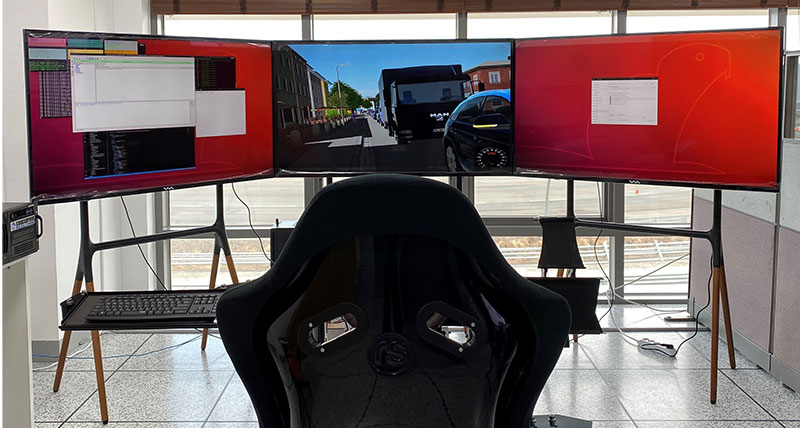Katech develops digital replica of Daegu city to enable autonomous vehicle certification and policy development
20 May 2021
Passenger vehicles can already read traffic signs or detect passing traffic, but the latest ADAS systems and autonomous vehicles are complex and, despite significant effort of manufacturers to ensure they respond to every event safely, governments require verification. Global authorities are developing methods to support the certification of vehicles and accompanying policy development so that next-generation vehicles can be safely and efficiently introduced to urban environments.
Vehicles are guided by sensors that ensure they are “situationally aware,” of their position and of any physical hazards, but this process becomes increasingly more complex in a city environment with unexpected hazards. South Korean research institution, KATECH, is helping automotive manufacturers and their suppliers develop the necessary the technologies and tests. The Institute is involved in the physical testing of self-driving vehicles and it wanted to implement them in a virtual environment to verify that safety-critical ADAS and autonomous systems will perform as intended in a realisitic urban environment. Through such research and development, it intends to build basic environment data and data to support certifications and laws related to autonomous driving in Korea.
KATECH invested in MSC Software’s Adams software to simulate vehicle dynamics in 2019, subsequently implementing its VIRES Virtual Test Drive (VTD) software for creating virtual road environments. By combining these industry-leading simulation solutions from Hexagon, it is now able to perform highly realistic simulations to understand how a specific vehicle with Advanced Driver Assistance Systems (ADAS) or autonomous capabilities will perform in real road conditions.
The industry faces a constant demand to link various solutions, and Seong-Jin Kwon, KATECH’s director of Vehicle Safety Research Center, says: “In order to study autonomous vehicles, all platforms, such as simulations and real vehicle tests, had to be built, including building an autonomous vehicle simulation environment, and using it to create conditions in which the driver either has to intervene, or not intervene, in real time. There have been many attempts to link everything, but it was harder than expected, so we had to proceed with the simulation and simulator parts that were realistically possible.”
One of those aspects was to model the entire South Korean city of Daegu Technopolis and Daegu National Industrial Complex and transfer it into a simulation environment. The city’s infrastructure makes it ideal for testing self-driving cars, and aims to establish itself as a global hub for conducting those tests. Dr. Seong-Jin Kwon says that as well as building precise maps for autonomous driving, there is also a real-time monitoring system for vehicles and their surrounding conditions, along with a data collection, storage and analysis system, making Daegu Technopolis and Daegu National Industrial Complex an optimised city for research on autonomous driving.
KATECH used Adams Real Time in combination with VTD and 3D mapping data from Hexagon’s Leica Geosystems business to build this virtual environment. Their team was already familiar with Adams for performing their vehicle dynamics tasks, and VTD was being used by other divisions. Combining these two solutions provided a comprehensive answer to complex toolchain issues. This is achieved by employing real-time simulation to provide the stability and deterministic results required irrespective of the variations in the fidelity of simulation that are introduced by including multiple vehicle dynamics models or different scenarios.
Developed specifically for the automotive industry, Adams Car enables KATECH to complete virtual prototypes of vehicles using prebuilt templates. “We run these through multiple open and closed-loop scenarios, meaning we can perform the same tests virtually, that the team usually runs in a test lab or on a test track.” It allows KATECH’s engineers to zoom into any aspect of the vehicle dynamics, and utilise the same vehicle model, during all stages of development, from design to validation.
Using standard tool-independent interfaces, Adams connects to VTD, enabling KATECH to create a virtual environment resembling the real world. “It means we’re able to simulate complex urban situations including pedestrians with unpredictable behaviour, weather variations, visibility, and vehicle dynamics. The combination of Adams and VTD is our starting point for analysing ADAS functionality and autonomous vehicles.” Dr. Seong-Jin Kwon says VTD easily met one of KATECH’s vital requirements – namely the ability to provide full flexibility to integrate with third party tools – and used data provided in the OpenDRIVE, OpenCRG, and OpenSCENARIO standard formats to create road networks and incorporate dynamic behaviour such as road surfaces and traffic.
Crucially VTD’s physics-based simulation of the LiDAR and RADAR sensors around a vehicle helps to determine “false-positives” where a vehicle’s perception of its surroundings is impaired. Because these sensor models employ ray tracing techniques, KATECH can scale from a few high-resolution images to a large number of lower resolution images depending upon the number of rays that must be simulated to adequately test a given system.
Hexagon provides multiple solutions, from early software development, right through to validating real prototype vehicles on the road. This includes road scanning with Leica Geosystems, validation of GNSS sensors with NovAtel, and vehicle prototype validation from AutonomousStuff. The complete solution from Hexagon reduces dependency on third party tools, enabling companies to perform full testing in-house.
Learn about autonomous driving solutions on the MSC Software website: mscsoftware.com/application/autonomous-driving
About Hexagon | MSC Software
Hexagon is a global leader in sensor, software and autonomous solutions. We are putting data to work to boost efficiency, productivity, and quality across industrial, manufacturing, infrastructure, safety, and mobility applications.
Our technologies are shaping urban and production ecosystems to become increasingly connected and autonomous – ensuring a scalable, sustainable future.
MSC Software, part of Hexagon's Manufacturing Intelligence division, is one of the ten original software companies and a global leader in helping product manufacturers to advance their engineering methods with simulation software and services. Learn more at www.mscsoftware.com. Hexagon's Manufacturing Intelligence division provides solutions that utilise data from design and engineering, production and metrology to make manufacturing smarter. For more information, visit hexagonmi.com.
Hexagon (Nasdaq Stockholm: HEXA B) has approximately 24,500 employees in 50 countries and net sales of approximately 5.4bn EUR. Learn more at hexagon.com and follow us @HexagonAB.
Press Contacts:
Robin Wolstenholme (UK-based)
Hexagon’s Manufacturing Intelligence division
Mobile: +44 (0)7407 642190
E-mail:robin.wolstenholme@hexagon.com or media.mi@hexagon.com

